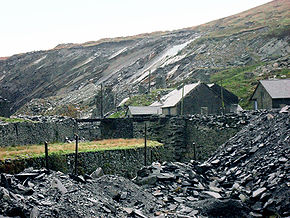Rhiwbach Tramway

The route of the Rhiwbach Tramway
|
|

The Rhiwbach Tramway passing to the left and below the main Maen Offeren mill level
|
|
| Locale | Wales |
|---|---|
| Dates of operation | 1861–1961 |
| Track gauge | 1 ft 11 1⁄2 in (597 mm) |
| Length | 3 miles (4.8 km) |
| Headquarters | Blaenau Ffestiniog |
The Rhiwbach Tramway was a Welsh industrial, 1 ft 11 1⁄2 in (597 mm) narrow gauge railway connecting the remote slate quarries east of the Blaenau Ffestiniog with the Ffestiniog Railway.
The first attempts to build a tramway to connect to quarries east of Blaenau Ffestiniog were made in 1854, when a petition to build the Ffestiniog and Macho Railway was presented to Parliament. This would 'authorise the construction of a new line of railway from Duffws to the Machno Slate Quarries and other purposes'. The intent was that this would be quite separate from the Ffestiniog Railway. The bill was promoted by Thomas Spooner, but was abandoned at the committee stage. One factor may have been the Ffestiniog Railway's insistence that all products produced by the quarries served should be exported via the railway, and this caused disagreement among the quarry owners. A second scheme was promoted in the late 1850s, to connect to the Rhiwbach Quarry, missing out the Penmachno Quarry. It was this scheme that was subsequently built.
The Ffestiniog Railway built an extension beyond Duffws in 1860, to connect to the end of the tramway, which they built in 1861, although it was financed by the Festiniog Slate Company Ltd, owners of the Rhiwbach Quarry. It was in use by two quarries in early 1862, but was not finally finished until early 1863. Quarries which used the tramway paid tolls to the Festiniog Slate Company.
The tramway remained in operation over its full length for close to a century. The section between Cwt y Bugail and Rhiwbach was lifted in 1956 and the section from Cwt y Bugail to Maenofferen was closed in 1961 and lifted in 1964. The first incline was replaced by a road, but a short section remained in use between the mills at Maenofferen and the foot of No 2 Incline, which became the last remaining gravity incline in the North Wales slate industry. This section was finally closed in 1976 after a new quarry road was built connecting the upper levels of Llechwedd with the mills at Maenofferen. Most of the track was lifted, although short sections of track remained intact as late as 2013.
...
Wikipedia
